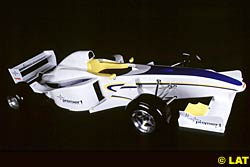|
Friday November 23rd, 2001
As Premier1 Grand Prix gears up for its first race in July 2002, Reynard Motorsport is preparing to design and build the 50 F1-style single seater race cars that will contest in the new series, representing some of Europe's top football clubs. Robert Synge of Reynard Motorsport, answers questions on the technical and logistical challenges ahead and explains why he believes the new Premier1 Grand Prix formula will provide spectacular on-track action. Q: What does the Premier1 Grand Prix contract mean to Reynard Motorsport? Synge: As a company, we're very excited about the concept of Premier1 Grand Prix as a way of presenting exciting, high-powered motor sport to a new audience so we worked hard to land this contract. Linking the worlds of football and motor racing is an idea that deserves to succeed and we wanted to support the idea as far as we could. Clearly an order for as many as fifty cars is highly significant to any race-car manufacturer and the Championship fits in very well with our current products in ChampCar, Formula Nippon and 675 SportsCar Q: Will the Premier1 Grand Prix car be based on either your current ChampCar or Formula One chassis? Synge: No. The Premier1 Grand Prix car will be a brand new design with a new monocoque and aerodynamic package designed to deliver the type of performance required. Q: Who will be designing the Premier1 Grand Prix car? Synge: James Bolton is our designer in day-to-day charge of the project, answering directly to John Thompson, our Chief Designer, and Nick Wirth, our Technical Director—both of whom are very involved in the design concepts for the car at this stage. Q: What will be the main technical features of the Premier1 Grand Prix racer and what kind of performance levels are expected from it? Synge: The car will feature a six-speed gearbox with a pneumatically operated, paddle gearshift and will run with carbon brakes. The performance we expect from the car—dependant obviously on driver skill, engine and tyre performance—will be as close to Formula One as we can make it. The regulations have banned the use of electronic aids so there will be a performance deficit in that area but the overall objective is to design a car that produces close, exciting racing where overtaking is possible and driver skill is paramount. Q: How far advanced are you with the project and what are your future timings and plans for design sign-off, testing and delivery of cars? Synge: The design processes have already begun and we will shortly be starting to wind tunnel test a scale model (photo available) of the 2002 Premier1 Grand Prix car. We are on target to have two cars testing in early April. Thereafter we will produce cars at the rate of six per week in order to deliver all 50 cars to Premier1 Grand Prix by the end of June 2002. Q: We are promised close and exciting on-track racing, how will your design encourage this? Synge: The significant fact here is that, unlike Formula One, all the drivers will be using an identical car, engine and tyres. The car will be very powerful with a 750 horsepower engine and the races will be short, sprint-type events with a pitstop purely to change tyres. The lack of driver aids will reward driver skill and encourage overtaking. Q: Will the Premier1 Grand Prix car meet all Formula One safety standards? Synge: Yes, Reynard prides itself on producing cars which meet, and where possible, exceed the statutory safety regulations and this product will be no exception. Q: Premier1 Grand Prix has said that it might also consider to race on ovals, how will this effect your design? Synge: The car will be built with safety very strongly in mind and our ChampCar experience will be very useful when Premier1 Grand Prix takes to the ovals in future years. Q: What kind of technical support will you be providing at the race circuits? Synge: Reynard will provide a full technical and spare parts support package at all the races and tests. Our engineers will be on hand to assist the teams wherever necessary but we don't envisage getting directly involved with engineering the cars on behalf of the teams—our role is that of supporting the teams and advising them on operating the car whenever our help is requested. Q: We understand you have received many interesting phone calls since signing the Premier1 Grand Prix partnership? Synge: Yes. There are many teams and drivers who have expressed an interest in getting involved with and supporting the Championship. There is certainly no lack of teams or credible drivers available to race in Premier1 Grand Prix and we've been very pleasantly surprised by the quality of both teams and drivers who wish to be involved.
Published at 19:16:21 GMT
| ||||||
 Premier1 Marketing Ltd and Reynard have released a scale model of the design for the proposed one-make series to rival Formula One.
Premier1 Marketing Ltd and Reynard have released a scale model of the design for the proposed one-make series to rival Formula One.